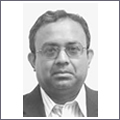Dipak Dey

M.S. 1977, Ph.D. 1980
Professor and Head of Department of Statistics, University of Connecticut
Written by: Shannon Knapp, Ph.D. candidate in Statistics
As a professor and the head of the Department of Statistics at the University of Connecticut, Dr. Dipak Dey's duties range from research and teaching to fund-raising and building bridges between disciplines.
Dey's research interests include Decision Theory, Multivariate Analysis, Bayesian Analysis, Biostatistics, Computational Statistics, Reliability and Survival Analysis, Statistical Shape Analysis, Statistical Genetics, and Bioinformatics. He has authored five books and published over 160 articles (with another two dozen submitted for publication) in journals ranging from the Annals of Statistics and The American Statistician to the Journal of Chemometrics and Evolution. In addition, Dey has served as Editor of the Institute of Mathematical Statistics Bulletin, Associate Editor of the Journal of the American Statistical Association, Sankhyā, and the Journal of Statistical Planning and Inference, and as a referee for 22 journals.
After time spent at Stanford, the University of Kentucky, and Texas Tech, Dey arrived at the University of Connecticut in 1985, and has been the head of the department there for the last ten years. Dey supervises the undergraduate program in Statistics and Math-Stat as well as the M.S. and Ph.D. programs in Statistics, and has developed a M.S. program with a Biostatistics concentration. He has also developed an alumni fundraising program and a scholarship and internship program with local industries for his department's graduate students.
Dey spends about half of his time on research, but with most of that done at home on nights and weekends and over the summer "vacation". Last summer, Dey went to Brazil giving five lectures, but managed to mix business with pleasure by traveling on the weekends. Much of his time during the work week is spent on administrative issues, solving problems for his department's 14 faculty members, mentoring junior faculty and graduate students, and in meetings. But meetings are part of research too, and include meetings with his graduate students, collaborators within the department, and collaborators across campus on his interdisciplinary projects.
Dey says he was always interested in teaching and research in Statistics. He studied mathematics in high school and was drawn to applied mathematics, which lead him to statistics. "During the 1990's, I felt that statisticians could contribute a lot to society by being involved in collaborative research with various scientists. After I became the Department Head, I got more involved with interdisciplinary, and cross disciplinary research, and biological, physical, and social scientists." As department head, Dey has been developing bridges between various other departments, colleges, and even the University of Connecticut medical school through interdisciplinary research. He is involved with various centers at the University of Connecticut, such as the Center for Public Health and Health Policy, Teachers for New Era, The Center for Internet Data Research and Intelligent Systems, and the Center for Environmental Sciences and Engineering. Dey also fosters the interdisciplinary approach among his students. Apart from taking courses in Statistics and Mathematics, Dey encourages statistics students to take a few science courses, depending on their interests. Dey's Ph.D. students working in Biostatistics and Bioinformatics take two appropriate courses from the Biology department.
Dey says he "received one of the best educations from the Purdue Statistics Department. I developed solid mathematical and statistical foundations from Purdue which helped me later to pursue various directions." Besides his degrees at Purdue, Dey says that his career has been helped by the exposure and practical experience he received visiting statistics, biostatistics, and computational biology departments in various universities around the world. "I also was a visiting scientist at the National Institutes of Standards and Technology for five years and visited several biopharmaceutical and insurance companies on and off to appreciate novel applications of statistics."
To incoming freshman, Dey advises, "If you like quantitative science and like data, you should study statistics. You don't need to be outstanding in mathematics. There are applications in all spheres." For example, if a student is interested in literature, and the quantitative aspects of literature (e.g., the frequency of word usage), they should study statistics. "The applications are endless."
To current students, Dey recommends joining the American Statistical Association as a student member as well as doing an internship during one summer with a company to get hands on experience with statistical data analysis. Dey also encourages students to attend seminars and meetings to think about and focus in on their research topic.
To graduating Ph.D. students, Dey says the most important thing he looks for in applicants for faculty positions is "a solid foundation of statistical theory and methodology with novel application." For example, if your research is in statistical genetics, your work should not merely be a routine consulting job for the biologist, but rather "pushing the frontier of biological research." Dipak Dey received the Statistics Outstanding Alumni Award from Purdue University, Department of Statistics in 2007.
To read more Alumni Profiles, please visit our Alumni Profiles archive.